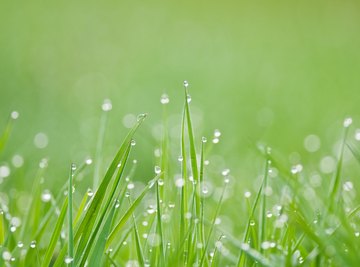
All living organisms require water for survival. For example, all oxygen-dependent organisms need water to aid in the respiration process. Water has many uses for organisms. The way that it is utilized can be categorized in four different ways: as a solvent, as a temperature buffer, as a metabolite and as a living environment.
TL;DR (Too Long; Didn't Read)
Living organisms need water to survive. Many scientists even believe that if any extra-terrestrial exists, water must be present in their environments. All oxygen-dependent organisms need water to aid in the respiration process. Some organisms, such as fish, can only breathe in water. Other organisms require water to break down food molecules or generate energy during the respiration process. Water also helps many organisms regulate metabolism and dissolves compounds going into or out of the body.
Water as a Solvent
Water attracts both positive and negative ions, because of the nature of the chemical bonds in water. Thus, positive ions are attracted to the oxygen in water, while negative ions are attracted to the hydrogen. This allows water to dissolve compounds important for survival, such as glucose gleaned from ingesting food.
Water as a Temperature Buffer
Temperature regulation is vital for chemical reactions important to cellular activity, such as cellular respiration. Enzymes, or proteins that act as catalysts to start chemical reactions, are heat-sensitive and will operate only at specific temperatures.
Water has a high specific heat capacity, meaning it takes a lot of heat to raise its temperature. Thus, water absorbs much heat without the temperature of the organism being raised. This prevents enzymes from becoming overheated and failing to function.
Water as a Metabolite
The sum total of chemical reactions within an organism is called metabolism. Water is a metabolite, or a chemical involved in reactions. In this way, it is is necessary for the continued survival of both plants and animals.
In plants, water aids in photosynthesis, the process by which plants convert sunlight into food. During the first stage of photosynthesis, water splits into hydrogen and oxygen atoms. Oxygen is released into the atmosphere, while hydrogen is used in the rest of the chemical reaction to produce glucose to feed the plant.
In animals, water aids in respiration. Water helps to split adenosine triphosphate (ATP) into adenosine diphosphate (ADP) and phosphoric acid. Cellular energy is released as a byproduct of this process. Water formation from oxygen and depleted hydrogen also moves waste products out of the body after the respiration cycle is complete.
Water as Living Environment
Water-based organisms such as fish require water to breathe, directly breathing the oxygen dissolved in water. Without a water supply, they could not access oxygen and would suffocate.
Water also helps insulate the living environment for these organisms. When the body of water is deep enough, the water keeps fish warm during the winter months, even when ice forms on the surface of the water.
References
About the Author
Jack Ori has been a writer since 2009. He has worked with clients in the legal, financial and nonprofit industries, as well as contributed self-help articles to various publications.
Photo Credits
Ivan Kmit/iStock/Getty Images
